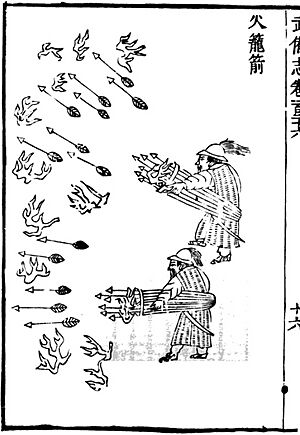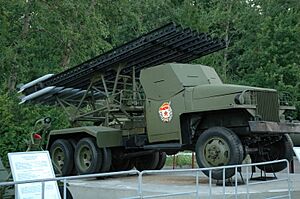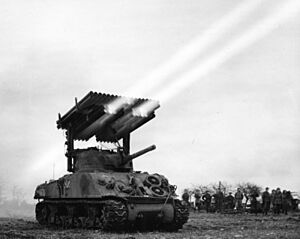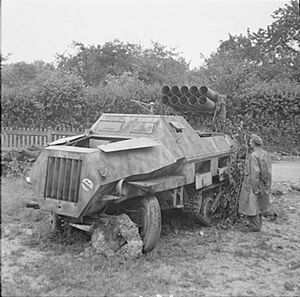Multiple rocket launcher facts for kids
A multiple rocket launcher (MRL) is a special type of rocket artillery system. It has many rocket launchers all fixed onto one vehicle or platform. These systems shoot many rockets very quickly, one after another, like a volley gun.
Rockets fly on their own and are different from regular artillery shells. They can fly much farther and often carry a bigger payload (what they deliver, like explosives). Early rockets were not very accurate and took a long time to reload. MRLs solve this by firing many rockets at once. This lets them cover a large area with powerful explosions.
Today, many rockets use GPS or other guidance systems. This makes them very accurate, combining the power of rockets with the precision of precision-guided munitions.
Contents
History of Rocket Launchers
The first multiple rocket launchers were invented in China during the Song dynasty. As early as 1180, Chinese soldiers used "fire lances" (early rockets) attached to pikes or arrows. They shot these at enemies. These rockets were even used during the Mongol siege of Kaifeng.
Later, Chinese armies made MRLs that could fire up to 100 small "fire-arrow" rockets at once. These rockets had a powder section about 10 to 15 centimeters long. The bamboo arrow shafts were 45 to 75 centimeters long. They could hit targets up to 300 to 400 paces away. The Chinese also added poison to the rocket tips. They even designed MRLs that one soldier could carry and use. Some were even mounted on wheelbarrows!
The Joseon dynasty in Korea created a larger MRL called a hwacha. This machine had 100 to 200 holes for rocket arrows and was placed on a two-wheeled cart. These arrows could fly up to 2,000 meters. The hwacha was very effective against invading Japanese armies between 1592 and 1598. A famous example is the Battle of Haengju, where 40 hwachas helped push back 30,000 Japanese soldiers.
Before World War II, European armies mostly used single, large rockets. The British used Mysorean rockets (from India) as the Congreve rocket. These were explosive rockets with simple launchers. Navies also developed MRLs for ships. However, regular artillery mostly replaced these weapons by the late 1800s.
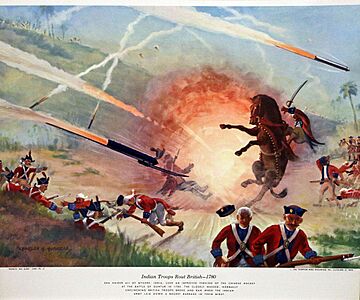
World War II Rocket Launchers
The first self-propelled MRLs (meaning they could move on their own) were the Soviet BM-13 Katyusha. These were first used in World War II and became very famous. They were simple: a rack of launch rails was put on the back of a truck. This design became the model for many modern MRLs.
The Americans put tube launchers on top of M4 Sherman tanks. They called this the T34 Calliope rocket launching tank. Only a few were made.
The Germans used a towed MRL called the Nebelwerfer during World War II. Allied soldiers called it the "Screaming Mimi" because of its sound. Later in the war, these launchers were put on modified trucks, becoming the Panzerwerfer 42 4/1. Another German MRL was inspired by the Soviet Katyusha. It was called the "Himmler-Orgel" or "Himmler-Organ."
Types of Multiple Rocket Launchers
There are two main types of MRLs:
- Fixed Tube Launchers: These MRLs have tubes or pipes, usually made of steel, that are permanently attached to the launcher. Rockets are loaded into these tubes one by one, either by hand or with some help. This type was common until the 2000s. They are easy to reload in the field without special tools.
- Container Launchers: These are more modern MRLs. They use special containers, pods, or modules that hold the rockets. These containers can be quickly removed from the launcher and replaced with new ones. This means different types of rockets can be used, or the launcher can be reloaded very fast. The containers are usually refilled at a factory or special army workshops. This design makes it easier to upgrade the system for new types of rockets.
Modern Use of MRLs
MRLs are still very powerful weapons. They can have a big impact on enemy soldiers, especially if those soldiers are not well-prepared.
Modern MRL systems use advanced navigation, like satellite navigation (GPS), to find their exact position quickly and accurately. This allows different MRLs to spread out and fire from various locations at the same target.
Some MRLs can use radar to track special rockets that explode in the air. This helps them figure out how wind and temperature affect the rockets' flight. This information is then used to make the next rockets hit their target more accurately.
Today, many MRL rockets are "precision-guided munitions." This means they have guidance systems like GPS, inertial navigation systems, or lasers. These systems help the rockets steer themselves to the target. This makes them incredibly accurate, often hitting within a few meters of the target, even from many kilometers away. This accuracy allows MRLs to be used effectively over very long distances.
The difference between a guided MRL rocket and a large guided missile is becoming less clear. For example, the M31 GMLRS is a guided MRL rocket that can hit targets with great precision.
See also
- Cake (firework)
- List of rocket artillery
- List of U.S. Army rocket launchers
- Rouketopolemos
- Transporter erector launcher



